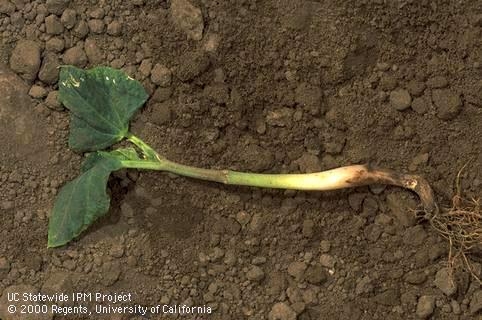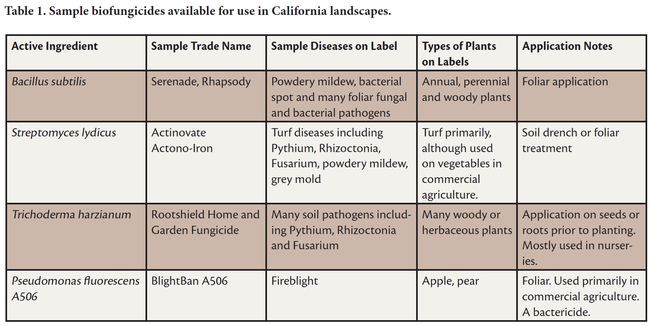[From the April 2014 issue of the UC IPM Green Bulletin newsletter]
The term biofungicide can have several different meanings, but it is most frequently used to refer to fungicides that contain a microorganism (usually a bacterium or fungus) as the active ingredient. 
Advances in fermentation technology have allowed mass production of highly specialized microbes that previously could only be grown in small batches on highly specific substrates, such as on roots infected with pathogens. Consumer demand for organically certifiable pesticides and increased regulatory pressure on older synthetic pesticides, especially in Europe, has 
Since microbial biofungicides contain living organisms, their modes of action differ from those of synthetic fungicides. Some of these mechanisms include:
- Competition: The biocontrol agent is more effective than the pathogen at gathering critical nutrients or space and, therefore, must be in place before disease onset.
- Antibiosis: The biocontrol agent produces a chemical compound of some type (antibiotic or toxin) that acts against the pathogen.
- Predation or parasitism: The biocontrol agent directly attacks the pathogen.
- Induction of host plant resistance: The biocontrol agent triggers a defensive response in the host plant that limits the ability of the pathogen to invade the plant.
Most biofungicides use one or more of the above mechanisms to target only one or a few specific pests. As such, applicators should both read the label and diagnose the problem carefully to insure that the product will be effective. Biofungicides work best when applied preventively. Application after a plant is already infected has little chance of significantly altering the course of the disease for that plant, although it may decrease the ability of the pathogen to move from that plant to other plants, especially if the pathogen has to move through the soil to do so. Thus, an application of biofungicide is not likely to cure an infected plant; but it may protect other nearby plants in the field.

Biofungicides cannot take the place of proper cultural care. They are a valuable tool for keeping a strong plant healthy, but they cannot forestall the inevitable. If your client's Japanese maples are routinely drowned, allowed to wilt, and then drowned again, adding a biofungicide will not prevent them from contracting Phytophthora if it is present in the soil.
If biofungicides are a useful and environmentally friendly tool in the landscape, why aren't they more widely used? One reason is that these fungicides rely on living organisms for efficacy, so they must be stored appropriately in order to retain their fungicidal properties over time. However, a more commonly cited reason is that the personal protective equipment needed to apply them is more involved than for some other compounds. Routine exposure to the proteins found in the spray mists of some biofungicides can result in the development of allergic reactions. To keep commercial applicators safe, they must wear NIOSH approved respirators when mixing, loading, or applying biofungicides in agricultural or landscape settings. This may not be immediately obvious when reading the labels, as a quick scan often only shows the following required personal protective equipment (PPE):
- Long sleeved shirt and long pants
- Shoes plus socks
- Waterproof gloves
The respirator requirement is only evident when reading the text following the list. Biofungicides are safe to use as long as mixer/loaders and applicators have and use a respirator as part of their PPE. However, a NIOSH approved respirator requires proper training and fitting in order to be effective.
When used properly and with forethought, biofungicides can be an important part of an IPM program to prevent or mitigate problems with plant pathogens in the landscape. However, nothing can ultimately take the place of proper plant selection and care.
